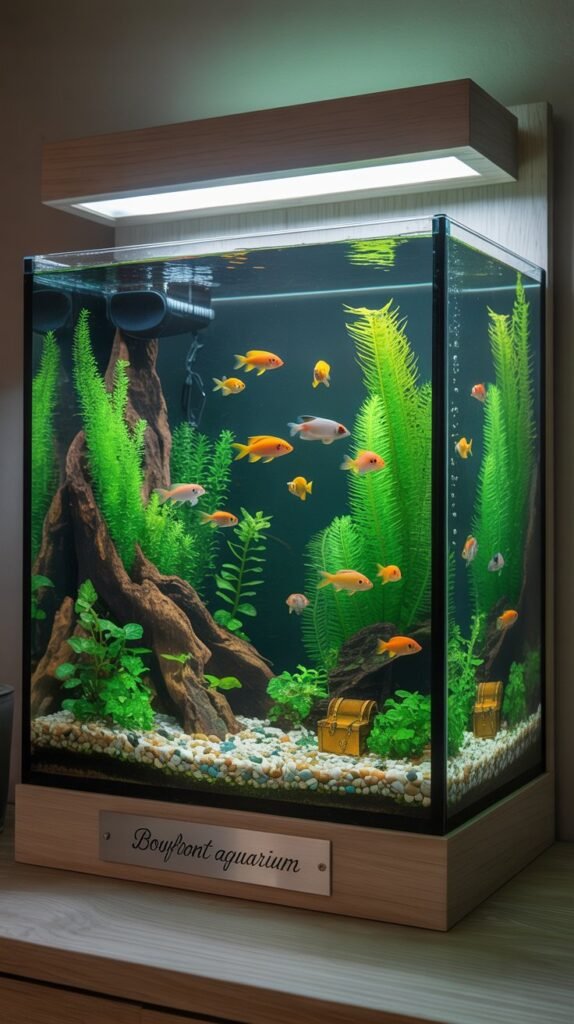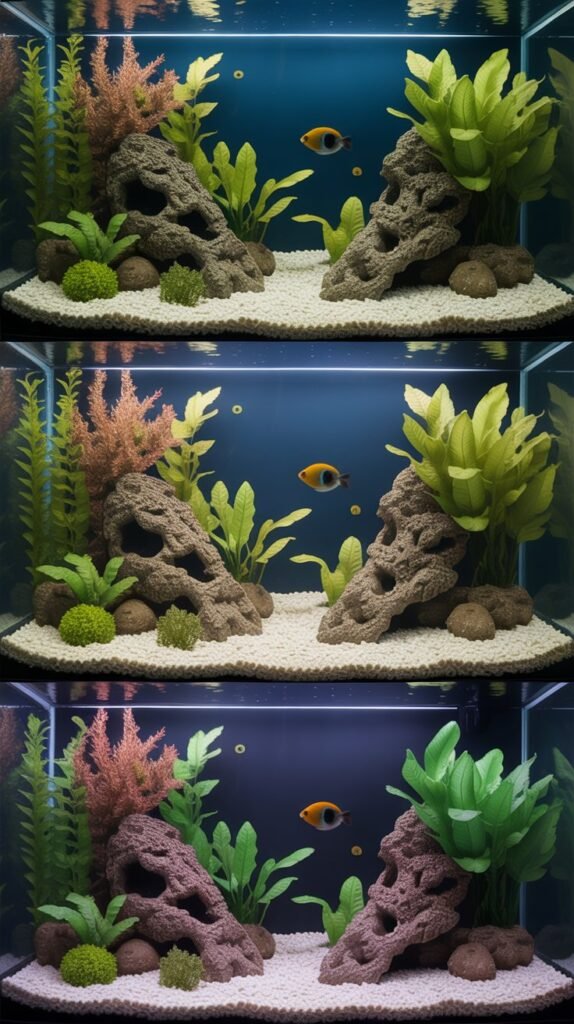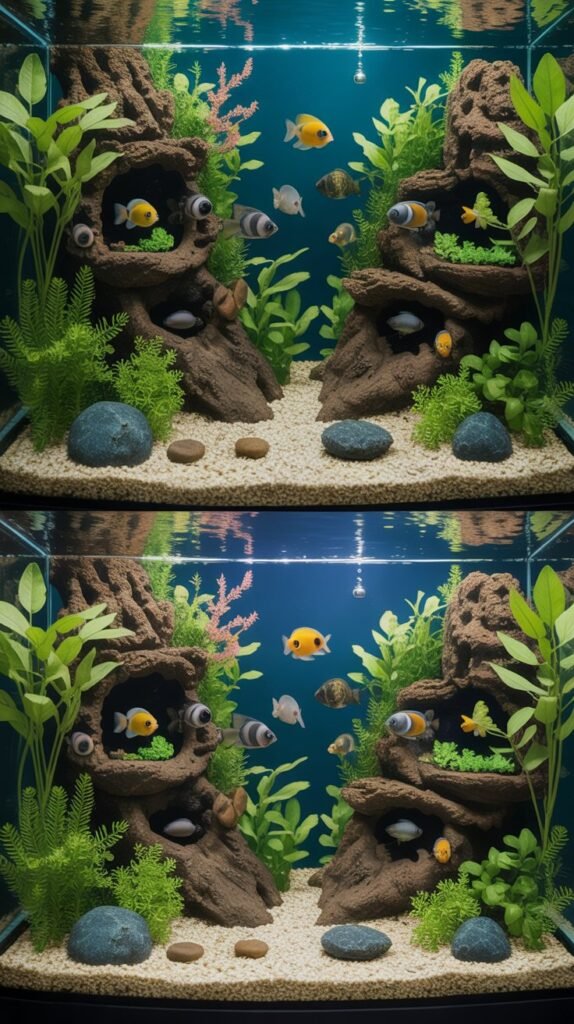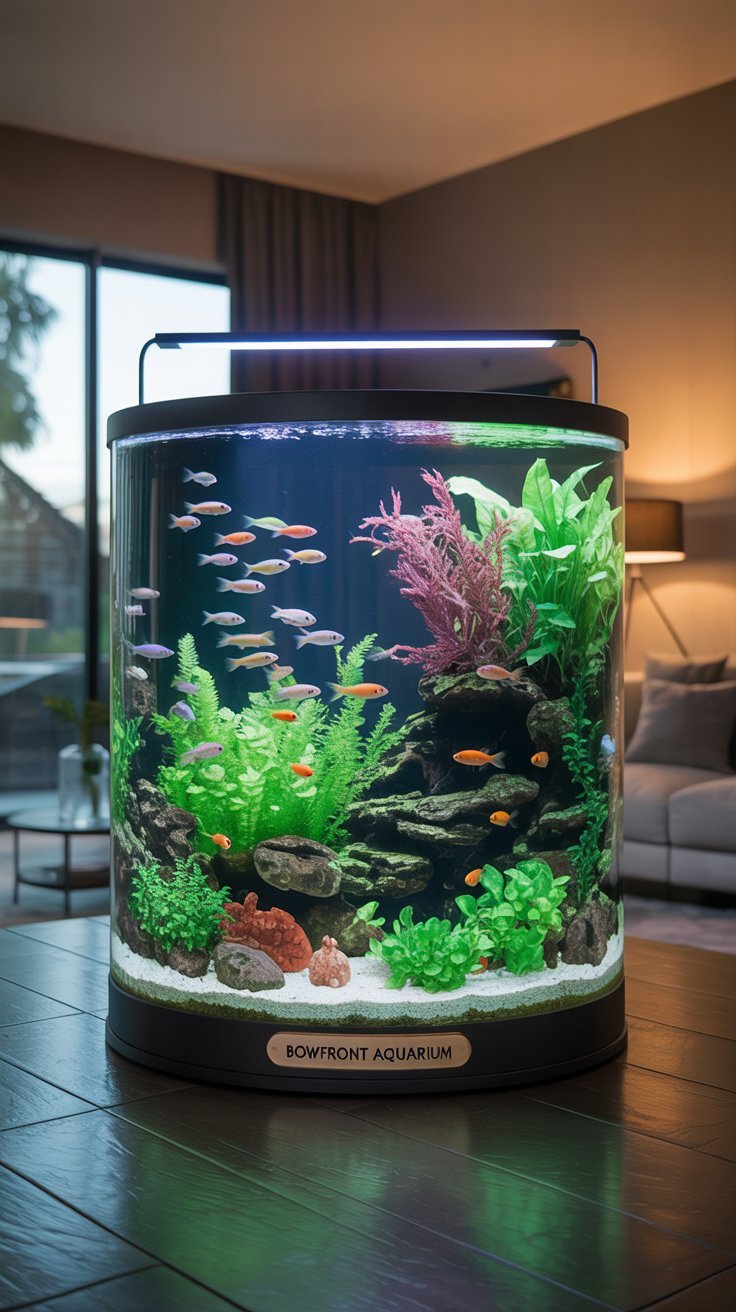When it comes to aquariums, design and functionality go hand in hand. While traditional rectangular tanks have long been the standard, modern aquascaping enthusiasts and fish keepers are increasingly drawn to bowfront aquariums. These tanks combine elegance with practicality, offering a stunning curved front panel that provides both aesthetic appeal and a unique viewing experience.
In this comprehensive guide, we’ll explore everything you need to know about bowfront aquariums — from their advantages and setup tips to maintenance, aquascaping ideas, stocking options, and much more.
What is a Bowfront Aquarium?
A bowfront aquarium is a type of fish tank designed with a convex, outwardly curved front glass panel. Unlike traditional flat-front tanks, the bowfront shape creates a panoramic view, enhancing the sense of depth and making fish and plants appear more vivid.

These aquariums are available in various sizes, from compact 16-gallon tanks ideal for beginners to massive 200-gallon setups perfect for advanced aquarists. The bowfront style is often considered a hybrid between functionality and aesthetics, making it a popular choice for living rooms, offices, and aquascaping displays.
Why Choose a Bowfront Aquarium?
Here are some key reasons why aquarists prefer bowfront aquariums over standard tanks:
1. Enhanced Viewing Experience
The curved front glass creates a magnifying effect, offering a more immersive perspective of the aquatic environment. Fish and plants look more dynamic and engaging.
2. Aesthetic Appeal
Bowfront aquariums stand out as decorative centerpieces in any room. Their unique shape adds sophistication and blends well with modern interiors.
3. Improved Depth Perception
The bow shape enhances the sense of depth inside the tank, making aquascapes appear more natural and layered.
4. Variety of Sizes
From small desktop versions to large statement aquariums, bowfront tanks come in a wide range of capacities to suit different needs.
5. Versatile Use
Bowfront aquariums can house freshwater fish, saltwater species, or even planted aquascapes. They are also suitable for reef tanks with corals.
Popular Bowfront Aquarium Sizes

Bowfront aquariums are manufactured in multiple sizes, making them suitable for both beginners and advanced hobbyists. Here are some common sizes and their uses:
- 16–26 Gallon Bowfront – Great for beginners, betta setups, or nano freshwater communities.
- 36 Gallon Bowfront – A balanced size for moderate fish stocking and aquascaping.
- 46–54 Gallon Bowfront – Ideal for intermediate aquarists looking to keep larger fish or small reef setups.
- 72–90 Gallon Bowfront – Provides ample space for advanced aquascaping, schooling fish, or marine setups.
- 100+ Gallon Bowfront – A large statement tank, perfect for high-end aquascapes, predator fish, or coral reefs.
Bowfront Aquarium Materials
Most bowfront aquariums are made of either glass or acrylic, each with unique advantages:
Glass Bowfront Aquarium
- Scratch-resistant
- Clearer viewing quality
- Heavier and less prone to bowing under water pressure
Acrylic Bowfront Aquarium
- Lighter and easier to move
- More impact-resistant
- Can scratch more easily but scratches are repairable
Setting Up a Bowfront Aquarium
Setting up a bowfront aquarium is similar to a standard tank but requires attention to its unique shape.
Step 1: Choose the Right Stand
Since bowfront tanks are curved, they require a specialized bowfront stand designed to support the shape. Flat stands may cause stress on the glass and lead to cracks.
Step 2: Select the Substrate
Depending on your setup, choose between gravel, sand, or aquasoil. For planted tanks, nutrient-rich aquasoil is recommended.
Step 3: Install Filtration and Heating
Ensure you select a filtration system strong enough to handle the water volume. For larger bowfront tanks, a canister filter is ideal. A heater should be chosen based on the tank’s gallon size.
Step 4: Aquascaping
The curved glass enhances depth perception, making it perfect for dramatic aquascaping layouts. Use rocks, driftwood, and plants strategically to maximize the effect.
Step 5: Fill and Cycle
Slowly fill the tank with dechlorinated water. Allow the aquarium to cycle for 4–6 weeks before adding fish to establish beneficial bacteria.
Best Fish for a Bowfront Aquarium

Choosing the right fish depends on the size of your bowfront tank. Here are some options:
For Small Bowfront Aquariums (16–26 gallons):
- Betta fish
- Neon tetras
- Guppies
- Cherry barbs
- Shrimp and snails
For Medium Bowfront Aquariums (36–54 gallons):
- Angelfish
- Gouramis
- Corydoras catfish
- Mollies and platies
- Small rainbowfish
For Large Bowfront Aquariums (72+ gallons):
- Discus fish
- Large schools of tetras
- Severum cichlids
- Saltwater reef setups with clownfish, tangs, and gobies
Aquascaping Ideas for Bowfront Aquariums
The curved glass of a bowfront tank makes aquascaping more visually engaging. Here are some ideas:
1. Nature Aquarium Style
Use rocks, driftwood, and carpeting plants to mimic natural landscapes.
2. Iwagumi Layout
Place stones in a triangular arrangement for a minimalist yet powerful look.
3. Jungle Aquascape
Dense plantings of Amazon swords, Vallisneria, and ferns create a lush jungle effect.
4. Reef Setup
For saltwater bowfront tanks, use live rock, corals, and marine-safe decorations.
Bowfront Aquarium Maintenance
Maintaining a bowfront aquarium ensures healthy fish and a clear viewing experience.
1. Water Changes
Perform 20–30% water changes weekly to maintain water quality.
2. Glass Cleaning
Use a curved algae scraper to clean the bowfront glass without scratching it.
3. Filter Maintenance
Clean filter media regularly but avoid washing with tap water (use tank water instead).
4. Check Equipment
Ensure heaters, lights, and filters are functioning properlyAdvantages of a Bowfront Aquarium
- Attractive design and panoramic view
- Enhanced aquascaping possibilities
- Unique focal point in a room
- Available in various sizes for different skill levels
Disadvantages of a Bowfront Aquarium
- Higher price compared to standard tanks
- Requires a specialized stand
- More difficult to photograph due to curved glass reflections
- Curved panels can distort fish slightly when viewed from certain angles
Bowfront Aquarium vs. Standard Rectangular Aquarium
| Feature | Bowfront Aquarium | Rectangular Aquarium |
|---|---|---|
| Design | Curved front, stylish | Flat, traditional |
| Viewing | Panoramic, immersive | Straightforward |
| Cost | Generally more expensive | More affordable |
| Stand Requirement | Specialized curved stand | Any flat stand |
| Aquascaping | Enhanced depth perception | Standard layout |
Tips for Success with a Bowfront Aquarium
- Use taller plants in the background to take advantage of depth.
- Position the tank where natural light won’t cause glare on the curved glass.
- Invest in quality lighting for planted or reef setups.
- Choose the right fish stocking based on tank size.
- Clean regularly with tools designed for curved surfaces.
Conclusion
A bowfront aquarium is more than just a fish tank—it’s a living piece of art. Its unique curved design enhances both aesthetics and viewing experience, making it an excellent choice for aquarists who want something beyond the ordinary. Whether you’re keeping freshwater community fish, planted aquascapes, or saltwater reefs, bowfront aquariums provide versatility and elegance.
With proper setup, care, and creativity, your bowfront tank can become the centerpiece of your home or office, captivating anyone who lays eyes on it.
FAQs About Bowfront Aquariums
Q1: Are bowfront aquariums more expensive than regular tanks?
Yes, bowfront aquariums typically cost more due to their unique design and specialized stands.
Q2: Do bowfront aquariums distort the view of fish?
Slight distortion may occur when viewing at sharp angles, but from the front, the view is immersive and clear.
Q3: Can I use any stand for a bowfront aquarium?
No, bowfront aquariums require a stand designed specifically for their curved shape to prevent stress on the glass.
Q4: Are bowfront aquariums good for saltwater setups?
Yes, bowfront tanks work well for both freshwater and saltwater aquariums, including reef setups.
Q5: What’s the best size bowfront aquarium for beginners?
A 36-gallon bowfront is often recommended for beginners as it offers enough space for a small community without being overwhelming.
Q6: How do I clean the curved glass of a bowfront aquarium?
Use a magnetic algae scraper or sponge specifically designed for curved surfaces to avoid scratching the glass.
Q7: Are acrylic or glass bowfront aquariums better?
Glass offers better scratch resistance, while acrylic is lighter and more impact-resistant. The choice depends on your preference.

